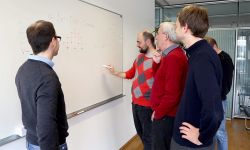
On Friday in Singapore, quantum physicist Rainer Blatt received the Quantum Communication Award 2016 for his pioneering experiments on quantum information processing with trapped ions and photons. Artur Ekert from the National University of Singapore was the second awardee of this prize.

Physicists in Innsbruck have realized the first quantum simulation of lattice gauge theories, building a bridge between high-energy theory and atomic physics. In the journal Nature, Rainer Blatt‘s and Peter Zoller’s research teams describe how they simulated the creation of elementary particle pairs out of the vacuum by using a quantum computer.

On Tuesday in Amsterdam, European quantum physicists discussed the state and development of quantum technologies. In the course of the conference, a Quantum Manifesto was presented. It calls for a common European initiative in Quantum Technologies to make sure Europe stays at the forefront of this technological revolution.

Peter Zoller is a scientific leader in quantum physics and a pioneer in quantum computing research. He has received many highly prestigious international awards and he is a frequent guest lecturer at top research centers around the world. Already in the mid-1990s, he and his colleague Ignacio Cirac proposed a concept to build a quantum computer and in recent years many aspects of the quantum computer have been implemented.

In an international first, a research team of experimental physicists led by Francesca Ferlaino and theoretical physicists led by Peter Zoller has measured long-range magnetic interactions between ultracold particles confined in an optical lattice. Their work, published in Science, introduces a new control knob to quantum simulation.